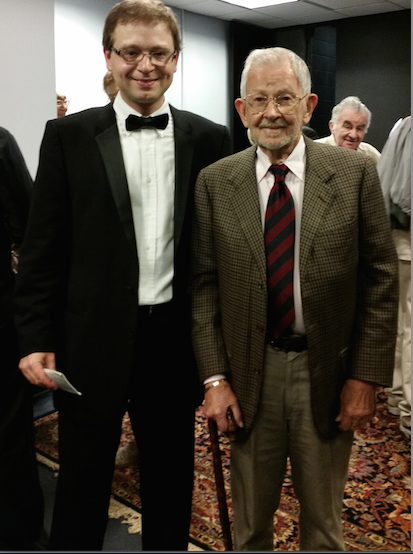Barber Reconsidered: Celebrating Samuel Barber’s 105th Anniversary
Maxim Anikushin, pianist, organist, harpsichordist, carilloneur; Eric Silberger, violin; Thelma Ithier-Sterling, soprano
Bruno Walter Auditorium, New York Library for the Performing Arts at Lincoln Center, New York, NY
September 26, 2015
Pianist Maxim Anikushin offered a lecture recital, exploring little known works by Samuel Barber, featuring both live and recorded performances on piano, organ, harpsichord, and carillon, as well as some videography. His multiple talents are undeniable, as is his enthusiasm for the material. The bulk of the program consisted of lots of small juvenilia from Barber’s childhood (as early as age seven) and adolescence. Perhaps, Barber knew best, however, never releasing these pieces for general publication, for they don’t really add much to our reverence for this iconic composer, and are mainly of academic interest.
Mr. Anikushin opened with the solo version of the Souvenirs, Op. 28. This was the only non-juvenile work, one that is pretty well-known to piano duos. Barber stated that he wished to evoke the charming music of the Palm Court at the Plaza Hotel. When done in the original four-hand, one piano version, more charm and intimacy are possible, and the genre emerges for what it is. Mr. Anikushin was most successful in the pathos-laden Pas de deux, and his tempo and lightness in the Two-step was a marvel to witness. Elsewhere, the music sounded a bit stiff (the solo pianist does have an awful lot to do) and needed a great deal more charm and flexibility.
There followed Three Themes (1923), a Menuetto, Andante religioso, and Allegretto on C, none of which revealed much originality, with a mélange of Classical styles as models. The Petite Berceuse (1923) had a poignant lyrical idea that repeated itself, each time landing on a novel harmony. The Essay II (1926) was more interesting in its adoption of certain “brutalist” gestures, possibly influenced by Stravinsky, as Mr. Anikushin pointed out in his remarks. Barber was fond of the concept of a musical “essay,” and named three mature orchestral works “Essay” as well. Two more childhood compositions: Sadness, and Lullaby (these were the age seven and nine works), were rather square. The Lullaby at least displayed ingenious cross-hand work, showing pianistic ingenuity, if not exceptional musical precocity.
Then came one of the most interesting byways of the concert: a three-movement Suite for Carillon (1930/33). Mr. Anikushin learned to play the carillon in several prominent locations in the U.S. (they all vary wildly in pitch and the weight of the wooden mallets one has to depress to activate the bells), following in Barber’s footsteps as an avid carilloneur. The sonority, accompanied by the clever video shot from the tower of New York’s Riverside Church, was lovely, inducing reverie in this post-Papal-visit New Yorker.
After intermission, Mr. Anikushin’s talent as an organist and harpsichordist was displayed. In a fragment of an intended Partita on a Bach chorale, all we heard was the Bach portion, which didn’t say much about Barber. Nor did the Fugue No. 5 from Five Fugues. The Canon No. 4 played on piano (then again on organ), a scant, busy, and difficult twenty-five seconds long, was accompanied by a whimsical video of a live bat that had entered Mr. Anikushin’s apartment.
The only completed movement from a Violin/Piano Sonata (1928) was given an excellent, passionate reading by the big-toned, bold romantic playing of Eric Silberberg and Mr. Anikushin. Their ensemble was excellent, and they managed to “paper over” some of the meanderings of the youthful Barber. They followed this with a “Gypsy Dance,” from an opera planned by Barber when he was twelve (The Rose Tree), which sounded mainly like warmed-over Fritz Kreisler in its inclusion of folkloric musical gestures.
The recital closed with a charming set of songs (again very early compositions), sung with expressive meaning and delicacy by Thelma Ithier-Sterling. The most shimmering, beautiful playing of the afternoon was Mr. Anikushin’s work as collaborative pianist in these songs, which didn’t venture much above “parlor” material, with the exception of the early version of “Daisies” (varying substantially from that found in Barber’s complete published songs) and the lovely “Slumber Song of the Madonna.” One of the songs was in French, a sophisticated choice for a boy, but the music emulated some portions of Fauré, without the French penchant for proportion and taste.
Mr. Anikushin clearly has a big technique and a lot to say, with his many instruments as well as his comments. He has been reviewed favorably in these pages before, by the estimable Harris Goldsmith. I would recommend that he do two things: 1) lavish his talents on better-quality music, and 2) remove the chip from his shoulder about funding, recording projects, procuring rights to music, etc. Come on Maxim, I know you’ve heard of Kickstarter, right?


